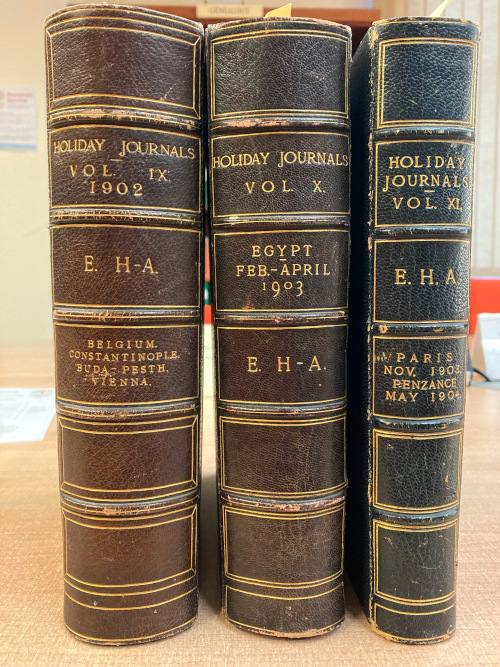Archives Hub feature for December 2022
The polymath Edward Heron-Allen (1861-1943) was a man of considerable talent and many interests. A solicitor by profession, his interests touched on a plethora of subjects: science, languages, literature and music. His pioneering treatise Violin-Making As It Was And Is, published in 1884, remains one of the key works on the instrument (the newest edition was published as recently as 2017). Heron-Allen’s study of Persian enabled him to publish a literal translation of The Rubaiyat of Omar Khayyam in 1898, and he lectured widely on the subject.
After moving to Selsey, a small fishing village on the Manhood peninsula in West Sussex, in 1911 (where he had built a house in 1904), Heron-Allen turned his attention to foraminifera (tiny, single-celled marine organisms) and published a large number of scientific papers, often in conjunction with the oceanographer Arthur Earland; as a result of this work, Heron-Allen was President of the Royal Microscopical Society from 1916-1917 and elected Fellow of the Royal Society in 1919. Anxious to serve in World War I, Heron-Allen enlisted in Selsey’s Home Guard (where he lined his uniform with silk, for comfort), but his linguistic abilities eventually saw him work for the intelligence services, where he devised propaganda before serving on the front line in France, on special duty.

Despite his grounding in the solid, traditional subjects of music, science, law and classical literature, Heron-Allen had a keen interest in the unseen and unknown world, and the occult. Under the pseudonym Christopher Blayre, Heron-Allen penned a number of early science fiction works, some of which are now regarded as classics, including The Cheetah Girl and The Purple Sapphire. This latter work was based on an amethyst which came into Heron-Allen’s own possession in 1890; supposedly cursed, Heron-Allen believed it wreaked havoc on his own life, to the extent that he eventually packed it in seven boxes and left it with his bankers, who were under strict instructions not to open it until 30 years after his death (it now forms part of the Natural History Museum’s collections). Years before he wrote his science fiction, Heron-Allen studied palmistry, publishing A Manual of Cheirosophy in 1885 and The Science of the Hand in 1886; such was his skill that he foretold the death of his younger daughter, Armorel, in a car crash in 1930, many years before the tragic event, merely by observing her hands.
Whilst Heron-Allen deposited many of his papers at institutions such as the Royal College of Music, the collection at West Sussex Record Office contains some of his more personal items, as well as copies of his many published works. Gathered for the most part by his grandson, Ivor Jones, the Edward Heron-Allen Collection (reference EHA) includes letters, visitor’s books, photographs, family material, and diaries, and it provides us with a clear sense of Heron-Allen’s personality.
The bulk of the collection is formed by Heron-Allen’s holiday journals, a meticulous, expansive set of 32 volumes, dating from 1885-1937, all written in Heron-Allen’s neat hand and featuring photographs and postcards alongside all manner of ephemera, from menus, wine cards, bills and receipts, train tickets and timetables, deck plans, and even laundry lists.

Locations range from British destinations such as Harrogate and Penzance, to European countries including Belgium, France and Italy, and further afield to Constantinople (now Istanbul), Egypt and Ceylon (now Sri Lanka). Whilst some journals record holidays, others record scientific trips, such as the survey of Clare Island (Ireland), alongside Arthur Earland, in 1911, and the British Association’s meeting at Dundee in 1912.


All provide evidence of Heron-Allen’s personality, as well as a slice of social and local history, and can provide wonderful detail for researchers interested in a particular locality visited by Heron-Allen.

Local history was another of Heron-Allen’s keen interests, and another subject in which he excelled. After moving to Selsey in 1911, Heron-Allen quickly published his epic work, Selsey Bill Historic and Prehistoric, providing an exhaustive geographical history of the area; a condensed, ‘popular’ version of this was delivered by lecture at Chichester High School for Girls in 1911, illustrated by lantern slides. Heron-Allen also produced numerous scholarly articles on the area, primarily for the Sussex Archaeological Collections.
Perhaps more accessible for many of us are his seven volumes of Selseyana, dating from 1901-1937, comprising press cuttings, reports of local associations, postcards, posters and handbills, and assorted other ephemera, all of which provide a compelling story of what it was like to live on the peninsula. As with his other work, Heron-Allen’s thirst for knowledge, eye for detail and compulsion to collect have provided us with a social as well as physical history of this small corner of West Sussex.

The Edward Heron-Allen Collection is freely available to view at West Sussex Record Office. For information on opening times, our location and access conditions, please click see our website.
The Edward Heron-Allen Society was formed in 2000. It hosts regular symposia and publishes a series of Opuscula, which concern the symposia and biographical matters relating to Heron-Allen. More about the Heron-Allen Society.
You can find out more about the Purple Sapphire on the Natural History Society’s website.
Nichola Court, Archivist
West Sussex Record Office
Related
The Edward Heron-Allen Collection, 1850 – ongoing
Browse the West Sussex Record Office descriptions to date on the Archives Hub

